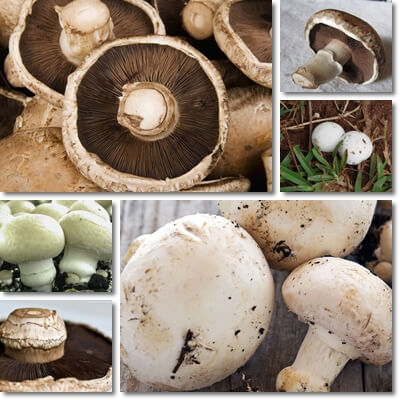The portobello mushroom goes by many names including portobella, portabella, crimini, cremini, champignon, button or white button mushroom, chestnut or brown or Italian or Roman brown mushroom.
All of these names refer to the exact same species of edible mushroom: Agaricus bisporus. But does the choice for one name over others mean something? Is there any difference between portobello and portabella, crimini and champignon, chestnut and white button mushroom and all the rest?
Essentially, all of these names and more are used to denominate the Agaricus bisporus species. Some of the names refer to the white variety of the species (example: white mushroom), while others refer to the brown variety (example: chestnut, Roman or Italian brown mushroom). Some are used to denominate younger specimens (example: button or white button mushroom), while others denominate older ones (example: flat mushroom). There may also be some regional differences but, for the most part, a lot of these names can be used interchangeably to designate the same species, Agaricus bisporus.

What are portobello mushrooms?
Portobello and its variants, portobella and portabella, refer to one of the most common species of edible mushrooms: Agaricus bisporus. These names do not however reflect the fact that there are two color variants: white and brown. Other names for portobello, such as the chestnut or white mushroom or Roman or Italian brown mushroom, seek to differentiate between the two color varieties.
An interesting aspect about the portobello is that it looks different in its immature form as opposed to its mature form: young specimens have a button-like appearance, hence the alternative name ‘button mushroom’, whereas mature portobellos have a larger, more flattened cap, hence the name ‘flat mushroom’.
Portobello vs portabella mushrooms
What is the difference between portobello and portabella mushrooms? Both names refer to the same species of edible mushroom, Agaricus bisporus. You can use either one. The only real difference is that ‘portobello’ is a masculine noun, while ‘portabella’ is a feminine noun (as per the source language, Italian). In English, the plural for ‘portobello’ is ‘portobellos’ or ‘portobellas’.
Portobello vs crimini mushrooms
What is the difference between portobello and crimini mushrooms? Portobello and crimini or its variant, cremini, are different names for the same species of edible mushroom, Agaricus bisporus. The two names can be used interchangeably. Some people use the name ‘crimini’ or its variant ‘cremini’ to refer to the immature portobello, in its button-like state and, sometimes, to the immature specimens of the brown variety, but this is not a general rule. It’s likely the more immature portobellos are labeled as ‘baby’: baby cremini/crimini, baby portobello or baby bella and should lack the elongated gills under the cap.

Cremini vs white mushrooms
What is the difference between cremini and white mushrooms? White mushroom is a more general name often used for the white variety of portobello mushrooms, aka Agaricus bisporus, but it can be used to denominate other species of edible, white mushrooms as well. Whereas cremini (or crimini) can be used to refer to the portobello in general, the immature portobello or the immature brown portobello variety, depending on the region and culinary culture. When buying from a supermarket, always check the scientific name on the label to know for sure what you are getting.
Portobello vs white button mushrooms
What is the difference between portobello vs white button mushrooms? Portobello and white button mushrooms are the same thing. The only difference between the two is that portobello may refer to either the white or the brown variety, whereas white button mushroom clearly refers to the white variety. In some cases, the name ‘white button mushroom’ is also used to indicate the more immature specimens with rounded, bulkier-looking caps and thicker, shorter stems (that look somewhat like buttons). The mature specimens have a larger, visibly flattened, umbrella-shaped cap. They also develop elongated, narrow gills under the cap.
Can you eat the gills of a portobello mushroom?
Yes, you can and you probably should too. Portobellos are safe to eat whole, meaning the cap with the gills underneath and the stem are all perfectly edible. Not only this, but they are an important source of nutrition, providing excellent amounts of several B vitamins and minerals such as phosphorus, potassium and selenium. Discarding any part of the mushroom will result in a lesser nutrient intake for you.
Also see the benefits of portobello mushrooms.
Cremini mushrooms vs chestnut mushrooms
What is the difference between cremini and chestnut mushrooms? They are different names for the same species, the Agaricus bisporus, better known as the portobello. The only real difference is that cremini (or crimini) can be used to refer to both the white and brown variety of the species, while chestnut mushroom refers specifically to the brown variety.
In some instances, the name chestnut mushroom may be used to refer to younger specimens of the brown variety which have a more rounded, bulkier-looking cap. The name may be a reference to both the brown, chestnut-like color and the rounded, bulky shape of the caps of the immature portobello specimens.
Portobello mushrooms vs champignon mushrooms
What is the difference between portobello vs champignon mushrooms? Both terms refer to the Agaricus bisporus species of edible mushroom and can be used interchangeably. The latter is quite a popular name for the species, especially in Europe. It is possible its popularity in European culinary culture is owed to the fact that it has French origins.
Portobello vs flat mushrooms
What is the difference between portobellos and flat mushrooms? You can use the term portobello to refer to Agaricus bisporus mushrooms, both the white and brown variety, at all stages of maturity. Or you can use the term flat mushroom to refer to mature Agaricus bisporus mushrooms, both of the white and brown variety. The mature specimens have a more flattened, umbrella-like cap, hence the alternative name for the species. However, since it’s a more general name (a lot of other mushroom species have flattened caps), it’s always wise to check the label for the scientific name to see what exactly you are getting.
